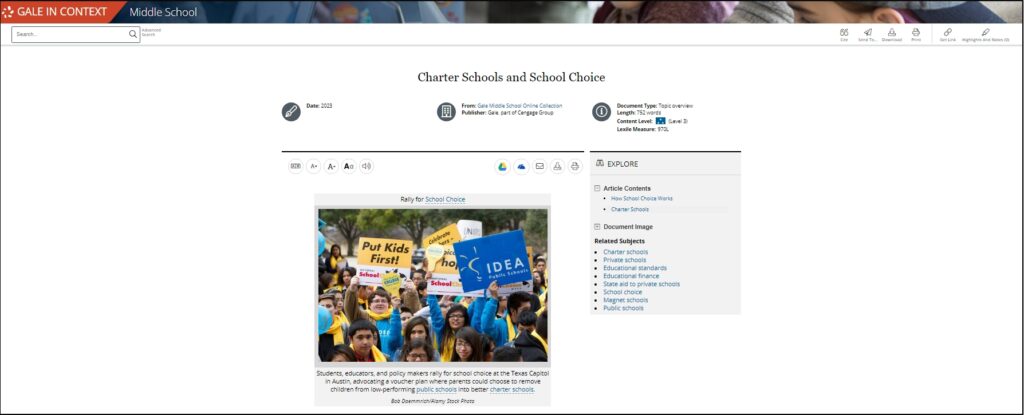| By Gale Staff |
Public schools have been the primary source of learning for students in K–12 in the United States since the 1800s. In the U.S., taxpayers fund these schools, providing education to millions of children each year. Public schools have helped countless students prepare themselves for careers or further education. They also give students access to various resources, such as special education services and extracurricular activities that the students might not otherwise have. Although public schools remain the most common way for children in the U.S. to be educated, alternative education methods are becoming more popular.
Teachers and students can learn about the different forms of education and some of their benefits and criticisms in new resources available in the Gale In Context: Middle School database. Teachers and students can research the topics and compare the different types of education to better understand why alternative education methods exist and who uses these other types. Then, teachers can engage students in conversations about what they’ve learned about education and why they believe these distinct types of education are popular.
Understanding School Choice
The term “school choice” is used to convey the idea that families have choices in how and where their children are educated; it also indicates that families can use government funds to educate their children in the way they want. School choice is often supported by people who advocate for using methods of education outside the public school system. Teachers can begin a discussion of school choice by talking about the origins and widespread popularity of public schools, as they are still the most common way that students are educated in the U.S. Teachers can also help students better understand school choice and how it affects students around the country by encouraging them to explore the new topic overview “Charter Schools and School Choice.” By reading the overview, students will discover what school choice is and why it’s often associated with charter schools, which are schools that are outside traditional public schools.
Depending on the type of school students attend, they may be unfamiliar with charter schools. Teachers can encourage their students to access the Related Subjects menu available in the overview. By accessing the topics in that menu, students can explore more resources dealing with public schools, charter schools, private schools, education standards, and more.
Discussing Other Forms of Education
After students understand the topic of school choice, they may want to learn more about the different forms of education that families choose to use. Homeschooling is one kind of education that’s become more popular in recent years. Some students may have experienced homeschooling, while others may not know what the term means. Students can access the new Homeschooling portal to learn about this form of education, which is when parents educate their children at home rather than sending them to a school—private, public, or charter. Students can begin their exploration of the portal by reading the topic overview to better understand the origins of homeschooling and its rise in popularity.
Students can also explore some of the resources linked to the portal to learn more about the topic. For example, the new article “Types of Homeschooling” may be useful because it explains that people use different methods of instruction or learning when homeschooling. Teachers and students can compare these different methods to discover the breadth of learning styles that all-encompass schooling. For example, teachers could compare unschooling, which rejects the idea of structured education, with homeschooling co-ops, which bring together small groups of homeschooled children for shared learning opportunities. Teachers can also encourage students to seek out resources that inform them about current trends in homeschooling. For example, teachers may advise students to listen to the audio resource “Why more Black families are opting to homeschool their children.” This audio file can help students better understand why some families choose homeschooling, leading them to recognize some of the trends happening in education.
Examining Grading and Education
As students learn about different kinds of education and what motivates people to choose one form over another, they may become more interested in the factors that affect education. One such factor is grading, which students can learn more about in the new Students and Grading portal. In the U.S. and other countries, educators often use grading systems to evaluate students in school. One of the most common grading systems in K-12 education is the A through F system, in which letter grades indicate student performance, with A being the best and F being the worst. Other types of grading systems also exist, such as numeric systems.
In addition to learning about types of grading systems, students can also discover the factors that influence student achievement, including grades. For example, students can review the Videos section in the portal to learn about what influences student achievement. The videos “Exercise and School Grades” and “Fast Food and School Performance” focus on how daily actions, such as eating and exercising, are often related to physical health and seem to be related to students’ results in school. From these videos, students will learn that making healthy choices about eating and exercising may help them achieve good grades. Teachers can encourage students to discuss how grading and other factors that affect student achievement can influence students’ educations as well as the choices they make about their education.




